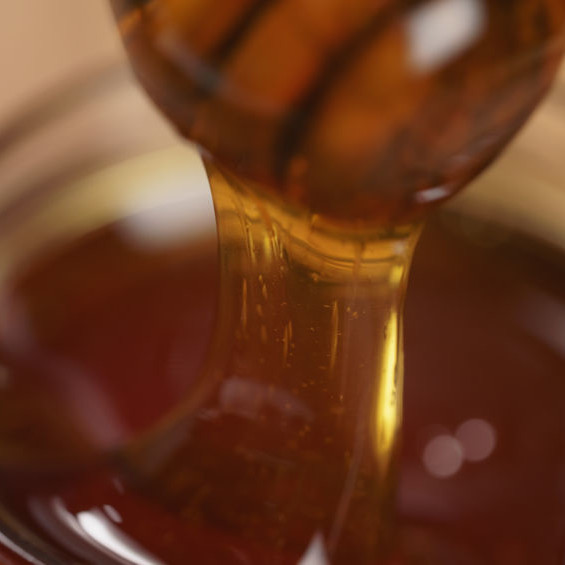
Honey
What is Honey?
Honey is a sweet, viscous substance produced by honey bees (Apis Mellifera) feeding on nectar or secretions of plants. It is one of the earliest sweeteners used in baking. The main carbohydrates present in it are glucose and fructose.1
It can be classified according to its source:
- Nectar
- Honeydew
Origin
Honey is an ancient food substance that dates back to the Stone Age. The earliest written reference of it is a Sumerian book written around 2100 BC. It was used as the main sweetener for food products until its substitution by an economic alternative: table sugar in the 1800s.2
Currently, honey is one of the last untreated natural foods available to consumers. It is harvested from bee hives after being produced by honeybees. China and Argentina are currently the main producers and exporters of this ingredient.2
Function3
It serves several purposes in baked goods, such as:
- Flavor: provides characteristic flavor notes to the baked goods
- Sweetness: displays a higher degree of sweetness in comparison to sucrose
- Color: imparts a brown color as a subtract for the browning reactions, Maillard reaction and caramelization
- Aroma: often a characteristic aroma of the specific plant source
- Moistness: the hygroscopic nature of honey increases the moistness and softness of baked goods
- Tenderization: interferes with structure setting
- Leavening: provides a source of acid for leavening. The typical pH is between 3.5 – 4.5
- Substrate for fermentation: the simple sugars are readily available for fermentation
- Sheen: provides a glossy sheen to icing as well as a smooth surface to smoothen the jagged irregularity of sugar crystals
- Retards spoilage: the lower water activity reduces microorganism growth
Nutrition
Carbohydrates constitute the main component with fructose and glucose making up to 65-95% of the overall carbohydrate content. These sugars are higher in the nectar variety (>60%) than in honeydew kind (>45%). This ingredient contains negligible amounts of protein ranging from 0.16-0.35 % of the product.1
Honey is a good source of antioxidants due to the presence of flavonoids, phenolic acids, ascorbic acid and carotenoids, among others. It is also considered a probiotic due to its oligosaccharides and low molecular weight polysaccharides.1
Types/variation
There are over 300 varieties produced from diverse forage of multiple plant species. There is not one kind completely identical to another.1
The two main sources are:
- Nectar: produced from multiple plant species
- Honeydew: produced from the secretions of living plants or excretions from plant-sucking insects
Commercial production4
Honey is one of the few food unprocessed products available to consumers worldwide. The following process describes the extraction and packaging:
- Comb removal: honeycombs are removed from the hives and stacked in pellets
- Extraction: honey is further extracted using uncapping machines
- Packaging: honey is filled into bottles and stored under controlled conditions
Application
Some considerations to keep in mind when using honey in cooking and baking:
- Temperature: baking temperature should be reduced by approx. 14 °C (25 °F) to discourage excessive browning in the oven
- Mixing: it should be added at the beginning of the mixing process to make it available to yeasts and support the leavening process
- Taste: the acidic flavor of this ingredient may be offset by adding ¼ teaspoon of baking soda
Honey can substitute for granulated sugar in baked goods at a 1:1 rate. However, the water or liquid must be reduced 15-18% of the sweetener weight.3 It is not recommended to substitute granulated sugar with honey for measurements above 1 cup, because the excessive liquid may cause considerable consistency changes.5
FDA regulations
Honey is an ancient food historically recognized as safe. The FDA has a regulation of which products are classified as honey and the proper labeling of the products containing honey. A mixture of this ingredient and other sweeteners can’t be classified as honey.6
References
- Kristbergsson, K. and Semih Ötleş. Functional Properties Of Traditional Foods. 1st ed., Springer Science + Business Media, 2016, pp. 323-350.
- Bogdanov, S..Honey as Nutrient and Functional Food. Bee Product Science,2016, pp. 1-6
- Figoni, P. How Baking Works: Exploring The Fundamentals Of Baking Science. 3 rd ed., John Wiley & Sons, Inc., 2011, pp. 50-165.
- Somerville, D. et al. Honey: Harvesting And Extracting. 1st ed., NSW Agriculture, 2017.
- Thacker, E. The Honey Book. 1st ed., James Direct, Inc., 2012.
- Food and Drug Administration (FDA). US Department of Health and Human Services. Guidance For Industry Proper Labeling Of Honey And Honey Products. Food And Drug Administration, College Park, 2014, pp. 3-4.

